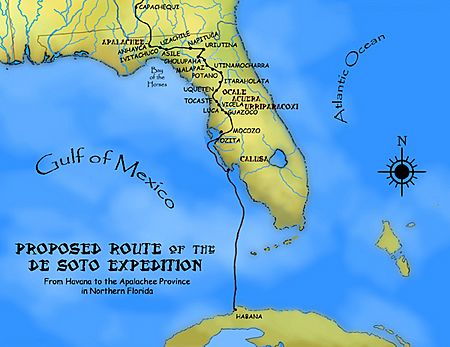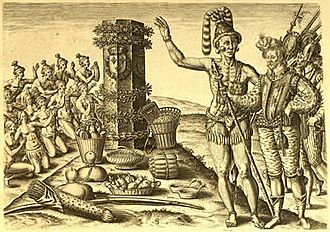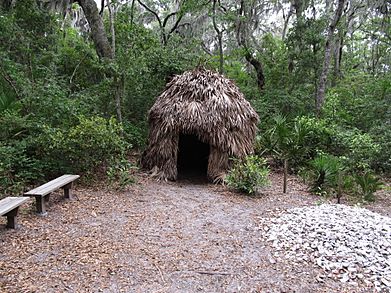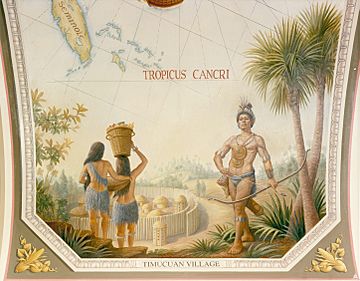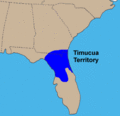Timucua facts for kids
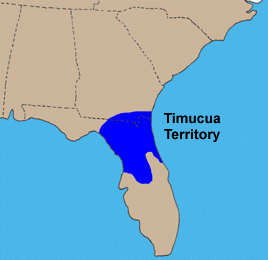 |
|
| Total population | |
|---|---|
| Extinct as a tribe | |
| Regions with significant populations | |
| Languages | |
| Timucua | |
| Religion | |
| Native; Catholic | |
| Related ethnic groups | |
| Numerous internal chiefdoms, 11 dialects |
The Timucua were a group of Native American people. They lived in parts of what are now Florida and Georgia. They were the largest native group in that area.
The Timucua had about 35 different groups, called chiefdoms. Many of these chiefdoms had thousands of people. These groups spoke different forms, or dialects, of the Timucua language.
When Europeans first arrived, about 200,000 Timucua people lived in an area of about 19,200 square miles. This area stretched from the Altamaha River in Georgia down to Lake George in central Florida. It went from the Atlantic Ocean west to the Aucilla River.
The name "Timucua" came from a word used by the Saturiwa people. They used it to describe another group, the Utina. The Spanish later used this name more widely for all the people who spoke the Timucua language.
The Timucua groups sometimes formed alliances, but they were never one single political unit. They had different ways of life. Sadly, many Timucua people died from new diseases brought by Europeans. By 1595, their population dropped from 200,000 to 50,000. By 1700, only about 1,000 Timucua were left. Slave raids by settlers from Carolina and their allies caused more deaths. The slave trade eventually led to the Timucua tribe disappearing completely in the early 1700s.
Contents
What Does "Timucua" Mean?
The word "Timucuan" might come from "Thimogona" or "Tymangoua." This was a name the Saturiwa people used for their enemies, the Utina. Both groups spoke different forms of the Timucua language.
The French used the name this way first. But the Spanish used "Timucua" for many groups in northern Florida. In the 1500s, the Spanish called the area north of the Santa Fe River "Timucua Province." This area became part of their mission system. The language spoken there became known as "Timucua proper." Later, the name "Timucua" was used for all people who spoke any dialect of the Timucua language.
Timucua History: What Happened?
Before Europeans arrived, the Timucua often had small wars with their neighbors. They were organized into about 35 chiefdoms. Each chiefdom had hundreds of people living in different villages. They sometimes worked together, but they were not one big group.
Archaeologists found a Timucua site in St. Augustine in 2006. It dates back to between 1100 and 1300 AD. This was more than 200 years before Europeans founded the city. They found pottery from Macon, Georgia, showing a large trade network. This is the oldest archaeological site in St. Augustine.
The Timucua might have been the first Native Americans to see Juan Ponce de León land in Florida in 1513. However, many historians now think he landed further south, so contact with the Timucua then was unlikely. Later, in 1528, Pánfilo de Narváez's group passed near the western edge of Timucua lands.
How Did Hernando de Soto Affect the Timucua?
In 1539, Hernando de Soto led an army of over 500 men through western Timucua lands. His army took food from villages. They forced women to join them and made men and boys serve as guides. The army fought two battles with Timucua groups. Many Timucua people were killed. After defeating some warriors, de Soto had 200 executed. This was called the Napituca Massacre. It was the first large massacre by Europeans in what became the U.S.
De Soto was in a hurry to find gold and food for his army. So, he did not stay long in Timucua territory. The Acuera were one of the few native groups who fought well against the Spanish.
French and Spanish Contact
In 1564, French Huguenots, led by René Goulaine de Laudonnière, built Fort Caroline near present-day Jacksonville. They tried to build more settlements. The French became friends with the local Timucua, led by Chief Saturiwa. Drawings by Jacques le Moyne, a French settler, help us understand the Timucua people.
The next year, the Spanish, led by Pedro Menéndez de Avilés, attacked Fort Caroline. They killed most of the French settlers. This ended French settlement in Florida. These events caused problems between the native people and the Spanish. However, Spanish missionaries soon arrived.
Spanish history changed after they built St. Augustine in 1565. It became the capital of their Florida province. Spanish missionaries built churches in the main Timucuan towns. By 1595, the Timucuan population had dropped by 75%. This was mainly due to new diseases from Europeans and war.
By 1700, only about 1,000 Timucua people were left. In 1703, Governor James Moore led settlers from Carolina and their native allies. They raided the Timucua, killing and enslaving hundreds.
A count in 1711 found 142 Timucua speakers living in four villages under Spanish protection. By 1759, only six adult Timucua and five mixed-heritage children were left under Spanish control.
In 1763, Spain gave Florida to Great Britain. The Spanish took the remaining Timucua and other native people to Cuba. Researchers are now looking in Cuba to see if any Timucua descendants live there. Some historians think a small group of Timucua might have stayed in Florida or Georgia. They might have joined other groups like the Seminoles. Many Timucua items are kept at the Florida Museum of Natural History.
Timucua Tribes and Groups
The Timucua were divided into many different tribes or chiefdoms. Each spoke one of about nine or ten dialects of the Timucua language. These tribes can be grouped into eastern and western parts.
The Eastern Timucua lived along the Atlantic coast and on the Sea Islands. This was in northern Florida and southeastern Georgia. They also lived along the St. Johns River and its smaller rivers. They usually lived in villages near water. They focused on getting food from the ocean and wetlands. All the known Eastern Timucua tribes became part of the Spanish mission system.
The Acuera tribe was different. They kept many of their old traditions even during the mission period. They are the only known Timucuan chiefdom to leave the mission system. They stayed in their original land and kept their traditional ways.
Some Timucua Tribes Were:
- Acuera
- Alachua
- Mocoso
- Ocale
- Potano
- Saturiwa
- Tacatacuru
- Utina
- Yustaga
The Western Timucua lived inland in the upper Florida peninsula. They stretched west to the Aucilla River and north into Georgia. They usually lived in forest villages. They focused on getting food from the forests.
Earlier experts thought tribes around Tampa Bay, like the Tocobaga, were Timucua speakers. However, some of these tribes might not have spoken Timucua.
How Were Timucua Groups Organized?
The Timucua were not one single political group. They had at least 35 chiefdoms. Each chiefdom had about two to ten villages, with one main village. In 1601, the Spanish noted over 50 chiefs.
Villages were divided into family clans, often named after animals. Children always belonged to their mother's clan.
Timucua Daily Life and Customs
The Timucua played two types of ball games. Western Timucua played a game similar to the "Apalachee ball game." Two teams of about 40 or 50 players kicked a ball at a goal post. Hitting the post was one point. Getting the ball into an eagle's nest at the top was two points. The first team to score eleven points won.
Eastern Timucua played a similar game, but they threw the ball instead of kicking it. They also enjoyed archery, running, and dancing.
The chief had a council that met every morning. They talked about problems in the chiefdom and smoked. Before the meeting, they had a "White Drink" ceremony. Council members were highly respected. They made decisions for the tribe.
Timucua Settlements and Homes
The Timucua in northeast Florida lived in villages with about 30 houses and 200 to 300 people. Their houses were small and round. They were made of upright poles covered with palm leaves. There was a hole at the top for air and smoke. Houses were about 15 to 20 feet wide and used mainly for sleeping.
Each village also had a council house. Some council houses were big enough for 3,000 people. If a village got too big, some families would start a new village nearby. This created groups of related villages. Each village or small group of villages had its own chief. Sometimes, villages formed temporary alliances for war. Ceremonial mounds might be in or near a village. These mounds belonged to clans, not just villages.
What Did the Timucua Eat?
The Timucua were semi-agricultural people. They grew crops like maize (corn), beans, and squash. Archaeologists think they might have rotated their crops. They used fire to clear fields. They prepared the soil with hoes. Women planted seeds using two sticks called coa. They also grew tobacco. They stored crops in special buildings to protect them. Corn was ground into flour to make corn fritters.
Timucua men hunted animals like alligators and manatees. They also fished in streams and lakes. They collected shellfish from fresh and salt water. Women gathered wild fruits, palm berries, acorns, and nuts. They baked bread from the koonti root. Meat was boiled or cooked over an open fire called a barbacoa, which is where the word barbecue comes from. Fish were cut into pieces and dried or boiled. They made broths from meat and nuts.
After the Spanish missions were built, the Timucua learned about European foods. These included barley, chickens, figs, oranges, peaches, pigs, and wheat. Native corn became an important trade item and was sent to other Spanish colonies.
A special black tea called "black drink" (or "white drink") was used in ceremonies. It was a strong tea made from the leaves of the yaupon holly tree. Only men in good standing with the tribe drank it. The drink was believed to be purifying, and those who drank it often vomited. This drink was important in most Timucua rituals and hunts.
How Did the Timucua Look?
Spanish explorers were surprised by how tall the Timucua were. They were often four inches or more taller than the Spanish. Timucuan men wore their hair in a bun on top of their heads, which made them look even taller. Skeletons found at a mission site showed men were about 64 inches (163 cm) tall, and women were about 62 inches (158 cm) tall.
Each person had many tattoos. Tattoos were earned through brave actions. Children started getting tattoos as they took on more responsibilities. People of higher social class had more detailed tattoos. Tattoos were made by poking holes in the skin and rubbing ashes into them. The Timucua had dark skin, usually brown, and black hair. They wore clothes made from moss and animal skins.
Timucua Language
The Timucua groups were never fully united, but they all spoke the Timucua language. We know a lot about this language compared to other Native American languages from that time. This is thanks to Francisco Pareja, a Spanish missionary. In the 1600s, he wrote a grammar book for the language. He also wrote religious books in both Timucua and Spanish.
In 2019, a new book by Friar Pareja was found. It was a guide for Catholics attending Mass, with Latin, Spanish, and Timucua notes. This was an exciting discovery! Other sources for the language include books by another missionary, Gregorio de Movilla, and letters from Timucua chiefs.
Pareja noted that there were ten dialects of Timucua. These usually matched the different tribal groups.
Learning More About the Timucua Language
A project is currently working to find and record all the words of the Timucua language. This project is led by George Aaron Broadwell at the University of Florida. There are now about 138,000 Timucua definitions online. These come almost entirely from old Spanish documents from the 1600s.
Dr. Timothy Johnson described how the Spanish and Timucua worked together to create a written version of the language. Spanish priests would give the Timucua pages of Spanish text. Then, the Timucua would translate it into their own language. Sometimes, they would change ideas to fit their own beliefs. For example, the Spanish often used their word for "serpent" to describe the Devil. But the Timucua never used their word for "snake" (elatubasa). This shows that the Timucua did not connect snakes with evil.
Images for kids
See also
 In Spanish: Timucua para niños
In Spanish: Timucua para niños


